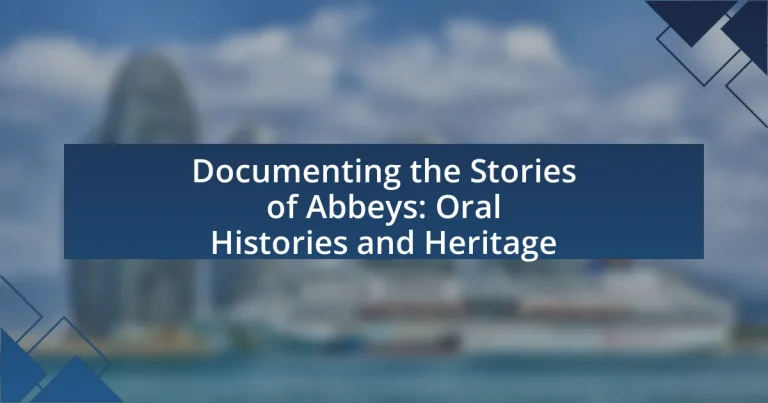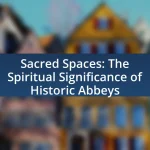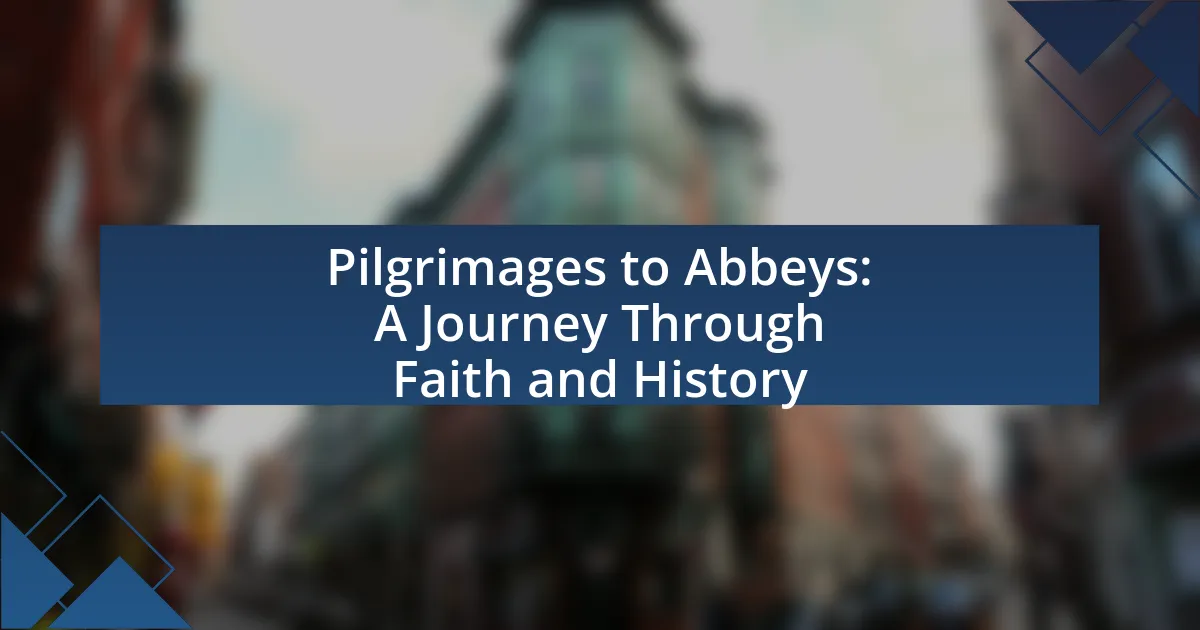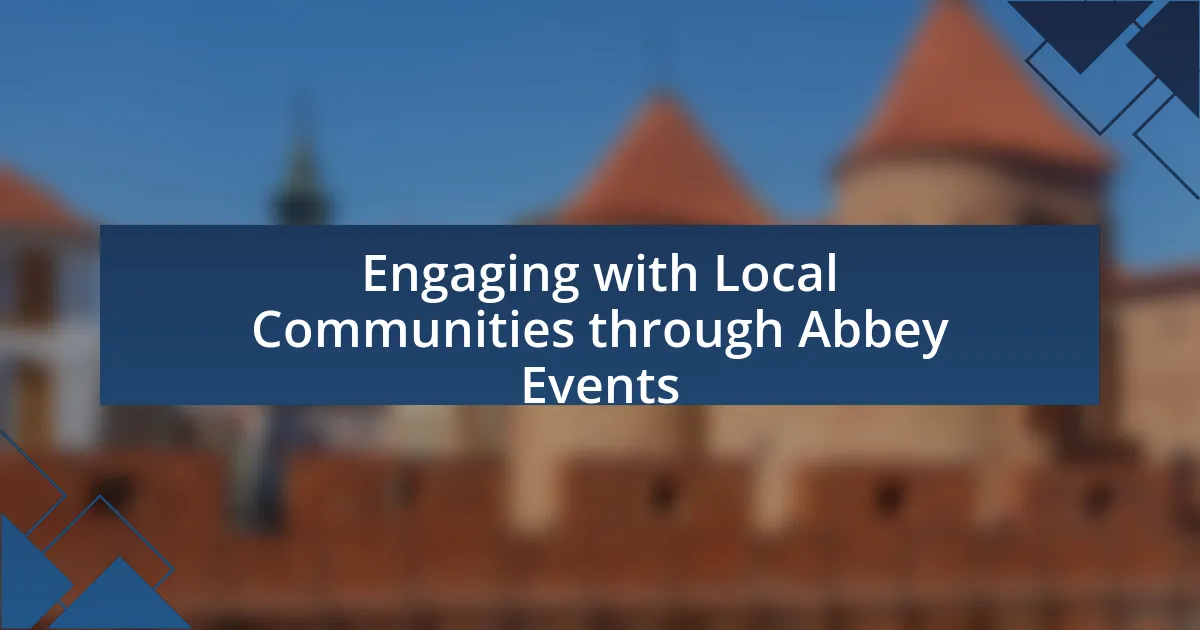Abbys are monastic complexes that have historically served as residences for monks and nuns, playing a significant role in the spread of Christianity, education, and agriculture during the Middle Ages. This article explores the cultural heritage contributions of abbeys, their impact on community development, and the architectural styles they embody. It emphasizes the importance of documenting abbey stories through oral histories, highlighting methods for collection, challenges faced, and the ethical considerations involved. Additionally, the article discusses how personal narratives enhance understanding of abbey heritage and the best practices for preserving these cultural narratives for future generations.
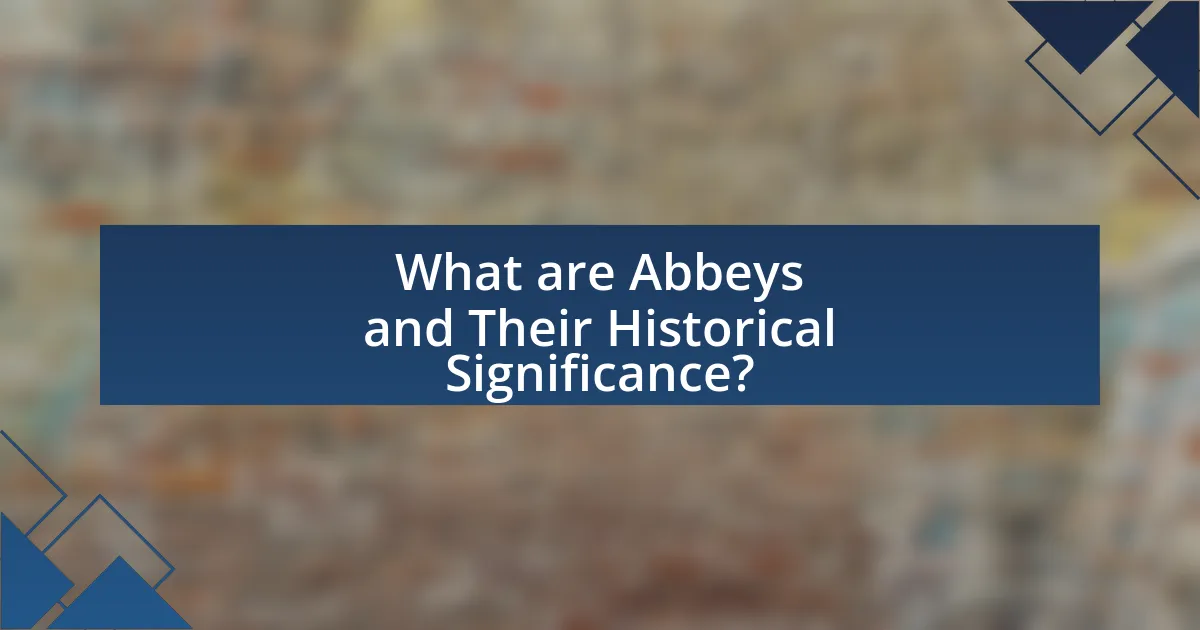
What are Abbeys and Their Historical Significance?
Abbys are monastic buildings or complexes that serve as residences for monks or nuns, often associated with specific religious orders. Historically, abbeys played a crucial role in the spread of Christianity, education, and agriculture during the Middle Ages, acting as centers of learning, culture, and economic activity. For instance, the establishment of the Benedictine Order in the 6th century led to the founding of numerous abbeys across Europe, which contributed to the preservation of classical texts and the promotion of agricultural innovations. Additionally, abbeys often served as places of refuge and community support, influencing local economies and social structures.
How have Abbeys contributed to cultural heritage?
Abbeys have significantly contributed to cultural heritage by serving as centers of religious, artistic, and educational development throughout history. These institutions have preserved and produced important manuscripts, artworks, and architectural styles that reflect the cultural values and beliefs of their time. For instance, the illuminated manuscripts created in abbeys during the Middle Ages are considered masterpieces of art and literature, showcasing the skills of monks and their dedication to preserving knowledge. Additionally, abbeys often hosted scholars and artists, fostering an environment of learning and creativity that influenced the cultural landscape of their regions. The architectural designs of abbeys, such as Gothic and Romanesque styles, have also left a lasting impact on European architecture, shaping the aesthetic and cultural identity of communities.
What role did Abbeys play in the development of communities?
Abbeys played a crucial role in the development of communities by serving as centers of religious, economic, and social life. They provided spiritual guidance and education, fostering a sense of community among local populations. Historically, abbeys often became hubs for agricultural innovation and trade, contributing to the local economy and supporting surrounding villages. For instance, many abbeys established extensive agricultural lands and engaged in trade, which helped to sustain and grow the communities around them. Additionally, abbeys often offered social services, such as care for the poor and sick, further solidifying their importance in community development.
How do Abbeys reflect the architectural styles of their time?
Abbys reflect the architectural styles of their time through their design elements, materials, and construction techniques that align with prevailing cultural and artistic movements. For instance, Romanesque abbeys, characterized by thick walls and rounded arches, emerged during the 10th to 12th centuries, showcasing the stability and strength valued in that era. In contrast, Gothic abbeys, which flourished from the 12th to the 16th centuries, feature pointed arches, ribbed vaults, and flying buttresses, reflecting a shift towards verticality and light, indicative of the spiritual aspirations of the time. The use of local materials and craftsmanship also illustrates the regional influences on architectural styles, as seen in the unique adaptations of abbeys across different geographical areas.
Why is it important to document the stories of Abbeys?
Documenting the stories of Abbeys is crucial for preserving cultural heritage and understanding historical contexts. These narratives provide insights into the religious, social, and architectural significance of Abbeys, which have played vital roles in community development and spiritual life throughout history. For instance, Abbeys often served as centers of learning and agriculture during the Middle Ages, influencing local economies and education. By recording these stories, we ensure that the contributions of Abbeys to society are recognized and appreciated, fostering a sense of identity and continuity for future generations.
What insights can oral histories provide about Abbey life?
Oral histories provide valuable insights into Abbey life by capturing personal experiences and cultural practices that are often overlooked in written records. These narratives reveal the daily routines, spiritual practices, and community dynamics within Abbeys, offering a more nuanced understanding of monastic life. For instance, interviews with former monks and nuns can highlight the significance of rituals, the role of hospitality, and the impact of historical events on Abbey communities. Such firsthand accounts enrich the historical context and preserve the intangible heritage associated with Abbey life, demonstrating how oral traditions complement and enhance documented histories.
How do personal narratives enhance our understanding of Abbey heritage?
Personal narratives enhance our understanding of Abbey heritage by providing unique, firsthand accounts that capture the lived experiences and cultural significance associated with these historical sites. These narratives often reveal personal connections to the Abbey, illustrating how individuals and communities have interacted with and been shaped by the heritage over time. For instance, oral histories collected from local residents can highlight specific traditions, rituals, and events that are not documented in formal historical records, thereby enriching the overall narrative of the Abbey’s significance. This qualitative data serves as a vital complement to traditional historical analysis, allowing for a more nuanced understanding of the Abbey’s role in shaping identity and community values.
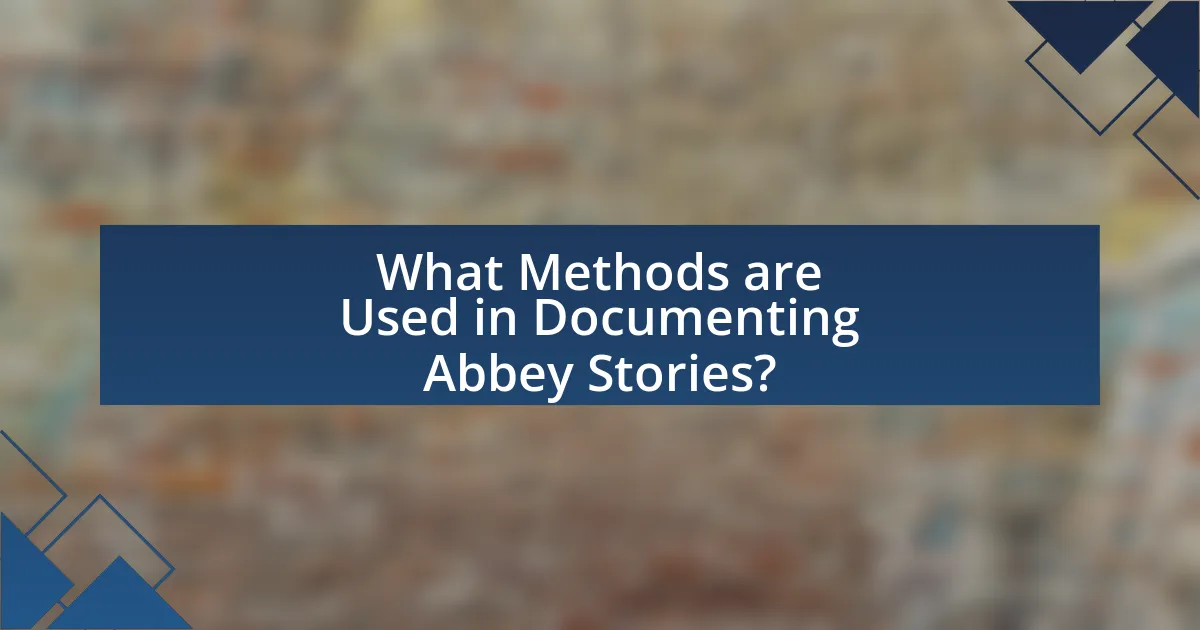
What Methods are Used in Documenting Abbey Stories?
Methods used in documenting Abbey stories include oral histories, written records, and digital archiving. Oral histories involve interviewing monks, nuns, and local community members to capture personal narratives and experiences related to the Abbey. Written records consist of historical texts, manuscripts, and archival documents that provide context and detail about the Abbey’s history. Digital archiving utilizes technology to preserve and share these stories through multimedia formats, ensuring accessibility for future generations. These methods collectively contribute to a comprehensive understanding of Abbey heritage and its significance in cultural history.
How is oral history collected from Abbey communities?
Oral history from Abbey communities is collected through structured interviews and community engagement initiatives. Researchers and historians typically conduct these interviews with monks, nuns, and laypeople associated with the Abbey, focusing on personal narratives, traditions, and significant events. This method allows for the preservation of unique cultural practices and historical insights specific to each Abbey. For instance, the Benedictine Abbey of St. John in the United States has utilized oral history projects to document the experiences of its members, ensuring that their stories contribute to the broader understanding of monastic life and heritage.
What techniques are effective for interviewing Abbey residents?
Effective techniques for interviewing Abbey residents include establishing rapport, using open-ended questions, and employing active listening. Establishing rapport helps create a comfortable environment, encouraging residents to share their stories more freely. Open-ended questions allow for deeper responses and insights, as they invite residents to elaborate on their experiences rather than providing simple yes or no answers. Active listening ensures that the interviewer fully engages with the resident’s narrative, demonstrating genuine interest and prompting further discussion. These techniques are supported by qualitative research in oral history methodologies, which emphasize the importance of creating a trusting atmosphere and facilitating rich, detailed accounts of personal experiences.
How can technology aid in the documentation process?
Technology can significantly aid in the documentation process by providing tools for efficient data collection, storage, and analysis. Digital recording devices, such as smartphones and audio recorders, enable high-quality capture of oral histories, ensuring that narratives are preserved accurately. Additionally, cloud storage solutions facilitate easy access and sharing of these recordings among researchers and the public, enhancing collaboration and dissemination of information. Furthermore, software applications for transcription and data organization streamline the process of converting spoken words into written text, making it easier to analyze and reference oral histories. These technological advancements not only improve the quality of documentation but also increase the accessibility and longevity of cultural heritage records.
What challenges are faced in documenting Abbey stories?
Documenting Abbey stories faces several challenges, primarily including the preservation of oral histories, the accuracy of historical records, and the potential loss of cultural context. Oral histories can be difficult to capture accurately due to variations in memory and storytelling techniques, which may lead to inconsistencies. Additionally, historical records may be incomplete or biased, complicating the task of creating a comprehensive narrative. The cultural context surrounding Abbeys can also shift over time, making it challenging to convey the original significance and practices associated with these sites. These factors collectively hinder the effective documentation of Abbey stories, impacting their historical integrity and cultural relevance.
How do language barriers affect oral history collection?
Language barriers significantly hinder oral history collection by limiting communication between interviewers and narrators. When participants do not share a common language, the depth and accuracy of the stories conveyed can be compromised, leading to incomplete or misinterpreted accounts. For instance, a study by the American Folklife Center highlights that language differences can result in the loss of cultural nuances and context, which are vital for understanding the significance of oral histories. Additionally, the inability to communicate effectively may discourage individuals from sharing their experiences, further diminishing the richness of the collected narratives.
What ethical considerations must be taken into account?
Ethical considerations in documenting the stories of abbeys through oral histories include informed consent, respect for cultural heritage, and the accuracy of representation. Informed consent ensures that individuals providing their stories understand how their narratives will be used and shared, which is crucial for ethical engagement. Respect for cultural heritage involves recognizing the significance of abbeys in their communities and ensuring that the narratives honor their historical and cultural contexts. Accuracy of representation is vital to prevent misinterpretation or distortion of the stories, which can lead to misinformation and harm to the communities involved. These considerations are supported by ethical guidelines in oral history practices, such as those outlined by the Oral History Association, which emphasize the importance of ethical responsibility in preserving and sharing personal and communal narratives.
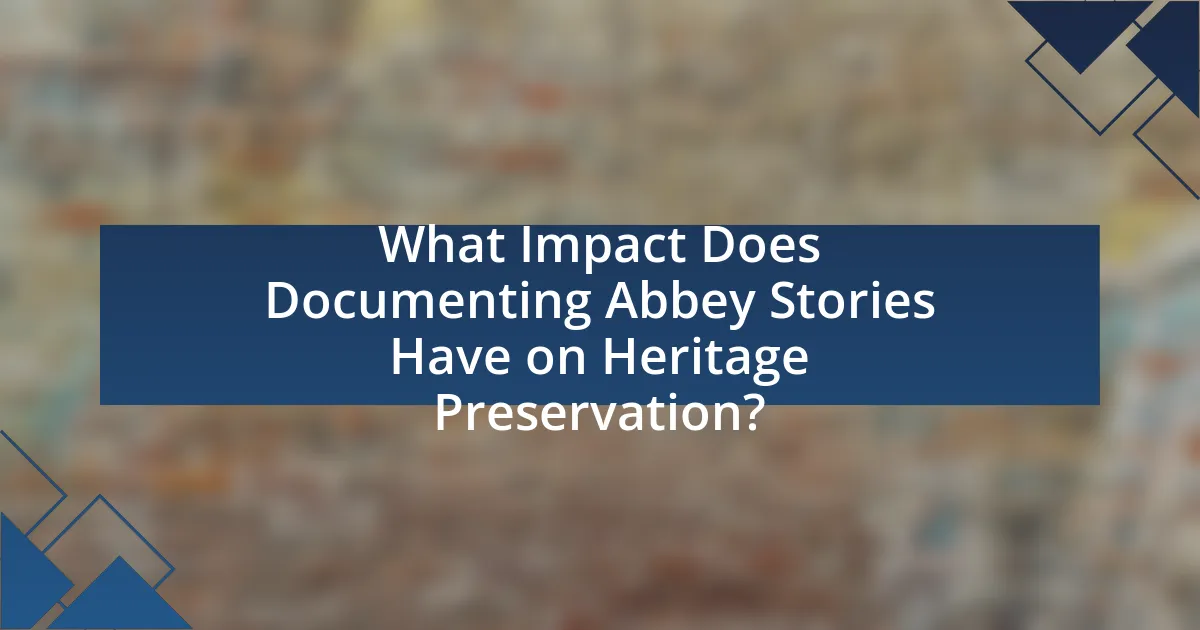
What Impact Does Documenting Abbey Stories Have on Heritage Preservation?
Documenting abbey stories significantly enhances heritage preservation by capturing and transmitting cultural narratives that might otherwise be lost. This process ensures that the historical significance, architectural details, and community connections associated with abbeys are recorded and shared, fostering a deeper understanding of their role in local and national history. For instance, oral histories collected from abbey communities can reveal unique traditions and practices, which contribute to a more comprehensive representation of cultural heritage. Studies have shown that such documentation efforts lead to increased public engagement and support for preservation initiatives, as communities become more aware of their heritage’s value.
How does oral history contribute to the preservation of Abbey culture?
Oral history significantly contributes to the preservation of Abbey culture by capturing and transmitting the lived experiences, traditions, and values of the Abbey community. This method allows for the documentation of unique narratives that may not be recorded in written form, ensuring that the cultural heritage is passed down through generations. For instance, oral histories can reveal specific rituals, architectural insights, and community interactions that define Abbey life, which are often overlooked in formal historical records. By engaging community members in storytelling, oral history fosters a sense of identity and belonging, reinforcing the cultural significance of Abbeys in contemporary society.
What role do community members play in heritage preservation?
Community members play a crucial role in heritage preservation by actively participating in the documentation and sharing of local histories and traditions. Their involvement ensures that cultural narratives, particularly those related to abbeys, are recorded accurately and passed down through generations. For instance, community-led oral history projects have been shown to enhance the understanding of local heritage, as evidenced by initiatives like the “Oral History Project” conducted by the National Trust, which emphasizes the importance of personal stories in preserving the significance of historical sites. This grassroots engagement not only fosters a sense of ownership and pride among community members but also enriches the broader narrative of heritage preservation.
How can documented stories influence future generations?
Documented stories can influence future generations by preserving cultural heritage and providing valuable lessons from the past. These narratives serve as a repository of experiences, beliefs, and traditions that shape identity and community values. For instance, oral histories from abbeys often encapsulate significant historical events, moral teachings, and community practices, which can guide future generations in understanding their roots and making informed decisions. Research indicates that storytelling fosters empathy and critical thinking, essential skills for navigating contemporary challenges, thereby reinforcing the relevance of documented stories in shaping societal norms and values.
What are the best practices for documenting Abbey stories?
The best practices for documenting Abbey stories include conducting thorough interviews with individuals connected to the Abbey, ensuring accurate recording of oral histories, and maintaining a structured approach to documentation. Interviews should focus on personal experiences, historical context, and cultural significance, allowing for rich narratives. Accurate recording can be achieved through audio or video methods, which preserve the authenticity of the stories. A structured approach involves organizing the collected data chronologically or thematically, which aids in analysis and accessibility. These practices are supported by heritage documentation guidelines, such as those from the International Council on Archives, which emphasize the importance of preserving cultural narratives for future generations.
How can researchers ensure accuracy in oral histories?
Researchers can ensure accuracy in oral histories by employing a combination of thorough interviewing techniques, cross-referencing accounts, and contextual analysis. Thorough interviewing involves preparing structured questions that encourage detailed responses while allowing for open-ended dialogue, which can reveal deeper insights. Cross-referencing accounts with existing historical records or other oral testimonies helps validate the information provided by interviewees. Contextual analysis situates the oral histories within broader historical, cultural, and social frameworks, enhancing their reliability. For instance, a study by the Oral History Association emphasizes the importance of triangulating data from multiple sources to corroborate individual narratives, thereby increasing the overall accuracy of the oral history collected.
What resources are available for those interested in documenting Abbey heritage?
Resources available for documenting Abbey heritage include archival materials, historical texts, oral history projects, and digital platforms. Archival materials can be found in local and national libraries, such as the British Library, which houses manuscripts and records related to abbeys. Historical texts, including books and scholarly articles, provide context and analysis of abbey heritage. Oral history projects, like those conducted by the Oral History Society, collect personal narratives that enrich the understanding of abbey life and culture. Digital platforms, such as the Heritage Lottery Fund’s website, offer funding opportunities and guidelines for documenting heritage projects. These resources collectively support the preservation and documentation of Abbey heritage.
